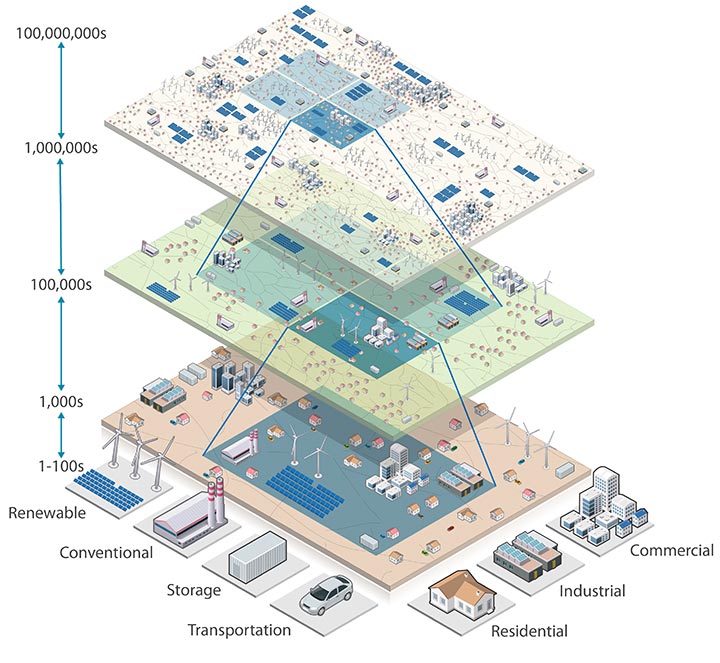Autonomous Energy Systems Expand Into Real-World Applications
With Strategic Partnerships, NREL's Bid for Intelligent, Self-Organizing Energy Systems Spreads Outside the Lab

What started as a vision paper and skillful controls for power flow is now influencing all fronts of the transition to clean and secure energy systems. The National Renewable Energy Laboratory's (NREL's) Autonomous Energy Systems work has been used commercially, applied in cross-cutting demonstrations, and is continually pushing the scientific edge of controls and optimization.
It was also the subject of a May 2022 workshop, "Autonomous Energy Systems – Strategic Public and Private Partnerships," which took a step beyond the basic science that has occupied much of the work to date, to gather input about applications on live systems.
"We have made fundamental breakthroughs in autonomous energy systems, really setting the course for a new body of work. Now we are looking to expand into partner applications that could benefit from this work," said Fei Ding, NREL research lead of the Autonomous Energy Systems Strategic Partnership portfolio. "This past workshop was meant to get stakeholders together to identify challenges and barriers, and to understand how we can apply what NREL has developed."

The two-day workshop kicked off with a review of past developments and introduced NREL's push for strategic partnerships around Autonomous Energy Systems. One such prior partnership, which applied advanced distribution system and distributed energy resources controls in a Colorado neighborhood, set the stage for how organizations can apply NREL's progress. Another ongoing partnership was introduced, in which NREL is lending technical expertise to a 580-building retrofit in Portland, Oregon, as part of the Building Technologies Office Connected Communities effort. The partnership will develop the building inventory into a 1.4 MW flexible load resource with the ability to participate in bulk services.
On the next day, discussion centered on opportunities for applications and demonstrations, and brought together representatives from a range of backgrounds—tech, vehicles, utilities, city governments, and product developers—to weigh in on how NREL's work will be useful and on what applications to explore next.
NREL's Autonomous Energy Systems research is creating automated and intelligent solutions at all scales and connecting all sectors. NREL is now developing strategic partnerships to prepare these solutions for system deployment.
Applications Already Underway
As NREL solicits input about how to steer the Autonomous Energy Systems portfolio, other projects are already carrying the work forward. The project REORG: Resilience and Stability Oriented Cellular Grid Formation, funded by the U.S. Department of Energy Solar Energy Technologies Office, is preparing for a field demonstration in Aspen, Colorado. The demonstration will feature a cell-based grid structure, in which the distribution grid can disperse into independent microgrids, or reintegrate, depending on circumstances. The REORG approach could be useful for resilience and efficiency, as communities can share energy with what resources are available.
Another of NREL's technologies, OptGrid, has been licensed by an energy software company for optimizing industrial applications, showing the versatility and generality of Autonomous Energy Systems controls. Like OptGrid, many of NREL's developments in this area are robust and ready for use—awaiting opportunities with partners to shape the algorithms into specific use cases. Much of the hard work is complete, and now attention is turning to applications. Meanwhile, NREL continues to innovate at the cutting edge with a group of new projects meant to serve all fronts in energy systems.
Opportunities To Expand, to Energy Systems and Beyond
Autonomous Energy Systems research follows the premise that future systems will be so full of devices, sensors, controllers, and data that they will be overwhelming to control, not to mention optimize. To make systems manageable, NREL strategies mix data science, artificial intelligence, and the laboratory's original hierarchical-decentralized controls for dynamic self-optimization. Building off its success, the laboratory is funding efforts to employ its approach far and wide.
One NREL-funded project is co-optimizing buildings and vehicles to accelerate renewable integration on the grid. The project is once again working at the frontiers of intelligent systems; it will bridge the sensors and controls needed to unite multiple domains and will incorporate recent artificial intelligence breakthroughs, culminating in a campus-scale demonstration of decentralized building-vehicle optimization.
Another project aims to develop advanced algorithms, engineering approaches, and technologies under an integrated framework of cyber-resilience in the design and operation of autonomous grids. The effort will lean on NREL's cyber range capabilities and will introduce mathematical approaches for quantification of cyber-resilience and system design, approaches for developing cyber-resilient controls, and zero-trust architecture for autonomous grids. Like other Autonomous Energy Systems innovations, this project will be relevant to the wider operational technology arena.
More than ever, NREL is equipped to support such projects and pursue partner applications. The Advanced Research on Integrated Energy Systems (ARIES) platform is sized and outfitted to show how controls and operation strategies can be deployed on real energy systems. The ARIES simulation capabilities can link the cyber and physical realms, enabling complex and cross-sector experiments that replicate what partners experience on the field.
If you are interested in learning more about Autonomous Energy Systems research at NREL and how to get involved, contact Fei Ding at [email protected] or Ty Ferretti at [email protected].
Last Updated May 28, 2025
